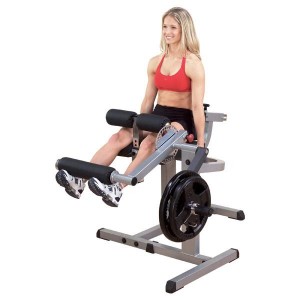
June 15, 2010
Changing Leg Position on Leg Extensions
Gym lore professes that altering the position of your legs while performing leg extensions can selectively target different aspects of the thighs. Evidence supporting this claim, however, is highly speculative.
Some studies have shown that turning your legs out (externally rotating them) increases stimulation of the vastus medialis (the teardrop-like muscle on the inside of your leg) and that turning your legs in (internally rotating them) shifts the emphasis to the vastus lateralis, the muscle located on the outer portion of your leg. If true, this would allow you to selectively target one quadriceps muscle over the other, providing a means to improve symmetry and correct strength imbalances in the quadriceps. Other studies, however, have shown no benefit to internal or external rotation of the legs during extensions, with the vastus lateralis and medialis receiving fairly equal work. When looking at the totality of research, the evidence of a beneficial effect is equivocal. At best, it would appear that the overall ability to target individual muscles of the quadriceps is minimal, with limited impact on strength and shape.
Now consider that employing the technique could come at a heavy cost. Even under ideal circumstances, the leg extension places a great deal of stress on the knees. Since loading is applied perpendicular to the long axis of the tibia, it creates tremendous shear force on the patellar region. What’s more, during performance, the quadriceps reacts to the movement by pulling the tibia forward (a phenomenon called tibial translation), causing the anterior cruciate ligament (ACL) to oppose the action. This can overstress the ACL, potentially injuring the ligament (and other soft tissue structures, as well).
Turning the legs in or out will only exacerbate these effects. Excessive internal or external rotation puts the patella in a position where it tracks in an unnatural way. Combined with effects of shear force and anterior tibial translation, stress to the knee capsule is heightened, significantly increasing the prospect of injury. This isn’t something to take lightly. An injury to the knee can set back your training efforts indefinitely, perhaps even requiring surgery and a lengthy rehabilitation stint.
Given the facts, I’d caution against any extreme rotation of the legs when performing leg extensions. The risk/reward ratio simply isn’t favorable. During performance, keep your toes straight or slightly angled out. This will allow optimal tracking of the patella and thus minimize injury potential. Your knees will thank you.
Stay Fit!
Brad
No Comments
No comments yet.
RSS feed for comments on this post.
Sorry, the comment form is closed at this time.






 Entries (RSS)
Entries (RSS)



